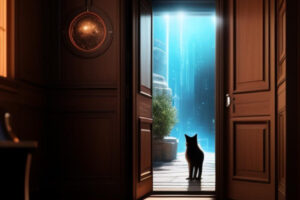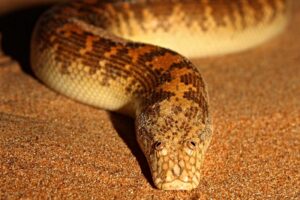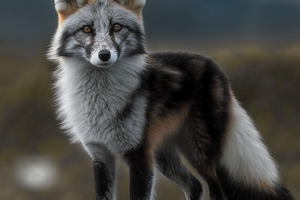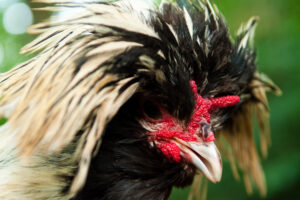Dogs cannot distinguish between green and red colors, i.e. have red-green color blindness
They can distinguish details at a great distance, but on the other hand, dogs do not see very many colors.
It’s not true that dogs can’t see colors, but they simply can’t distinguish as many colors as humans. On the other hand, they see better at dusk and can easily detect small movements.
The sight of dogs has been studied more than the sight of most other animals, and many have probably heard it thrown away that dogs see everything in black and white. Although dogs see fewer colors than we do, it is quite clear that they see colors and can even distinguish up to 40,000 shades. We humans, on the other hand, can distinguish more than one million shades.
Dogs’ eyes are equipped with the same type of color-sensitive cells, so-called cones, that we humans have at our disposal. We actually have three different types but only two dogs. The dogs’ cones are sensitive to blue and yellow light on the one hand, and they can taste blue from yellow, but not red from green.
Scientists therefore believe that dogs see the world like people who cannot distinguish red from green, and that they see these two colors like shades of gray.
It can also be noted that dogs see what is close to them more poorly than humans and are less sensitive to changes in brightness. However, dogs’ pupils can expand more than humans, and they have a reflective surface in the retina called the tapetum lucidum. Both improve vision at dusk.
Dogs also have more types of sensory cells called rods than humans. The characters only detect shades of gray, but are also extremely sensitive to light and can detect tiny movements at great distances.
Snails correctly analyze the environment
The garden snail’s vision is rather hazy, but it can nevertheless detect nearby enemies, as well as spot food, such as heads of lettuce.
Garden snails in particular have limited vision, but enough so that they can seek refuge in their cochlea if threatened.
The miniature garden snail, which is found in so many places, is equipped with eyes at the far end of the fins. His eyes are hard to make out, but they look like two small black dots.
Vision is rather limited, because even though the eyes are equipped with a pupil at the front of the fluid-filled cavity, there is a complete lack of muscles to control the pupil. This makes snails unable to sharpen their vision. Scientists therefore believe that snails distinguish shapes and shadows beyond seeing images of what is in front of their eyes.
For example, snails can sense that another snail is nearby when they crawl around, become aware of movements in the environment, as well as a shadow falling on them, which is enough for them to seek shelter inside the cochlea.
The garden snail’s eyes also do not contain any light-sensitive optic cells. He sees only shades of gray and can only distinguish between light and dark. The ability to detect brightness means that snails seek shelter in dark places when they have to hide for long periods of time, for example in winter.
Despite their poor vision, it should be noted that garden snails’ vision is sharper than that of most other molluscs, including mussels and octopuses.
The praying mantis can detect the direction of light
The praying mantis is one of the few animal species that can see polarized light that emerges in the direction the light is moving and can provide information about the movements of its prey.
No known animal has such keen eyesight as the praying mantis. The brain of this tiny crustacean has grown to be able to process all the data of vision.
The praying mantis has more perfect vision than any other animal known to scientists. The eyes move independently of each other and contain sensory cells that distinguish up to twelve different colors, i.e. four times more colors than humans can see. The praying mantis is also able to see how the light is polarized.
Light and other electromagnetic waves always oscillate at right angles to the direction of propagation, and the polarization reveals the direction in which they oscillate and also whether a potential prey or enemy is approaching or moving away from the praying mantis. The polarization provides the praying mantis with particularly detailed information regarding the sight when the animal is hunting, now or on the run.
The closest we can get to this vision is through the use of polarizing glasses or polarizing lenses on cameras. The light that hits our eyes swings in all directions. The filtering means that the direction caused by the reflection of sunlight on the water surface is then filtered out, allowing us to look into the water.
Man sees many shades
The eyes of the praying mantis have twelve different color-sensitive cells at their disposal. Although there are four times more photoreceptors than we humans can boast of, we are equipped with a brain that makes our vision more perfect than that of the praying mantis.
The praying mantis: 12 separate colors
The eyes of the praying mantis sense light waves in the range of 300-720 nanometers. Within that spectrum, the shrimp can see twelve different colors, but the brain is unable to combine them. For taste, the praying mantis can distinguish shades 4-20 times worse than humans.
Lorem ipsum dolor sit amet, consectetur adipiscing elit. Ut elit tellus, luctus nec ullamcorper mattis, pulvinar dapibus leo.
A giant mussel sneaks a peek
The edge of the mussel’s mantle is covered with tiny eyes called eyespots, which the animal can use to distinguish light from darkness and sense when an enemy is approaching.
The giant mussel, which weighs 200 kg, sees the outside world as luminous dots through a myriad of tiny eyes.
The giant mussel is the world’s largest mollusc. Some of the animals live to be over one hundred years old, reach 1.2 meters in diameter and weigh 200 kg. This giant animal also has some of the simplest eyes in the entire history of evolution, but these eyes are called eyespots.
Each eye spot consists of a cavity with an opening that acts as an aperture, while the posterior part of the cavity is covered by hundreds of light-sensitive cells. The mussel can distinguish three different colors, but not combine them into hues.
For this simple eye to be useful, the giant mussel must be equipped with many such eyes. As a result, the edge of the so-called mantle of the giant mussel is covered with hundreds of eyespots, each of which is about 0.5 mm in diameter.
These rudimentary eyespots allow the giant clam to react to light and shade. Research has further shown that the giant mussel can react to movement and shape, for example before a predator casts its shadow directly on it.
When Australian researchers first demonstrated that the giant mussel is supersightly in 1986, they were surprised to find that it was able to detect variations in light intensity in different parts of the visual field.
Bees see ultraviolet color
The bee’s eyes allow it to better see the pollinators of the flowers and actually act as a kind of landing lights.
Flying honeybees have two types of eyes that help them find the flowers with the most honey.
The bees see with two compound eyes consisting of 4,500-5,500 immovable individual eyes called pinnae. The compound eyes provide bees with color vision, which has a completely different function than our human vision.
We have sensory cells for blue, green and red light, but bees have for blue, green and ultraviolet. In other words, bees cannot detect red and orange light, but can see blue and green very well. They can also see ultraviolet light, i.e. light with short wavelengths that are invisible to us humans.
Many flowers take advantage of the unique vision of bees by being equipped with stripes on the petals, so-called nectar marks that point the bees to the honey. In this way, the bees can find the flowers that are ready to be pollinated.
In addition to the compound eyes, bees also have three so-called eyespots on top of their heads. The eyespots detect, among other things, changes in light intensity and can also detect the shadow of enemies who intend to attack bees from above.
Scientists have also found so-called directional neurons in the bee’s brain. Directional neurons process data from special visual organs that enable bees to see the direction in which the light is deflecting, which is also called polarization.
The polarized light creates a luminous streak across the sky that the bees use to navigate. The bees spot the streak, even if the sun is hidden behind a thick cloud cover.













